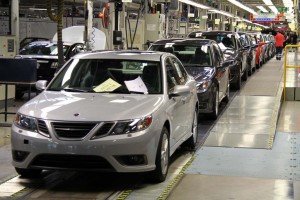
The Saab assembly plant, in Trollhattan, has been shut down for two weeks due to a supplier boycott.
With new funding coming and reluctant suppliers now beginning to ship parts again, Saab’s headquarters plant could be up and running in a matter of days, according to company and industry sources.
Operations at the maker’s Trollhattan, Sweden factory ground to a halt, two weeks ago, when parts makers staged a boycott demanding Saab follow up on unpaid bills. Despite company claims that there was still more than $200 million in the bank, the move set off a frantic search for more capital. Russian banker Vladimir Antonov then offered to assist by buying up Saab’s assets and leasing them back to the troubled maker.
On Friday, Swedish Enterprise Minister Maud Olofsson announced the government had decided “to conclude an agreement with Saab” that would help it get past a cash crunch triggered by slow sales last year.
The deal would allow the asset sale to Antonov, who controls a number of banks in the former Soviet block, including Bankas Snoras, in Lithuania. Antonov was a one-time partner of Saab Chairman Victor Muller who purchased the Swedish carmaker from General Motors in early 2010. Muller, a Dutch entrepreneur, got into the automotive business, a decade ago, by founding a low-volume sports car company, Spyker. But Antonov was forced out because GM declined to do business with the Russian.
He got his foot back in the door, earlier this year, by buying the Dutch sports car operation. Now it is likely that Antonov will also wind up with a stake in Saab. He has expressed an interest in directly investing up to $71.5 million – and has promised to limit himself to a minority stake.
Minister Olufsson said on Friday that the asset transfer should bring at least 30 million Euros to Saab in the near-term, though officials also expressed concerns that the carmaker was giving up assets worth significantly more.
According to Muller, the Swedish government’s approval is, “a very big step in the good direction,” though he admitted the company still has problems to work out.
Muller has insisted that last year’s sales shortfall reflected the problems of restarting the Trollhattan plant – which was down for seven weeks while the sale was finalized – and the challenge of rebuilding Saab’s global marketing and sales operations. He has stressed that cost cuts will allow the maker to break even on volumes of just 80,000 vehicles a year, about 40% below the sales it achieved mid-decade under GM.
Lending support to his optimistic forecast is the current launch of Saab’s first-ever sport-utility vehicle, the 9-4X, which is being produced at a GM plant unaffected by the Trollhattan shutdown.
